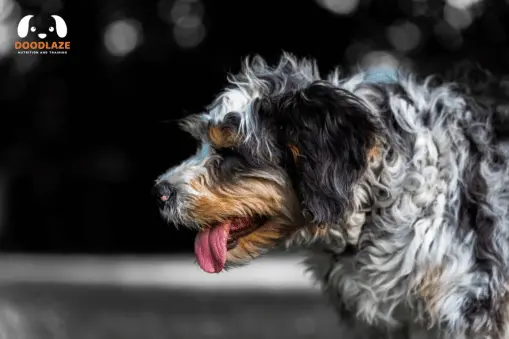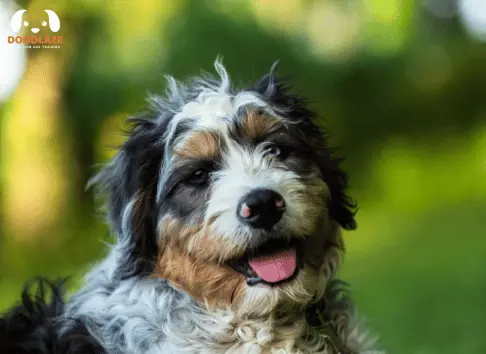Phantom Bernedoodle Colors: The Wide Range Of Shades 2024
A Phantom Bernedoodle is a widely renowned tri-colored pup among the most commonly owned pets. With a diverse color combination, they surely attract eyes and create a visually stunning combination that further adorns their look.
After an extensive amount of research, we’ve carefully calibrated a guide that will help you understand their color patterns and choose your next pets for breeding processes carefully. While it might not be entirely difficult to understand their color schemes it surely can be a bit tricky.

Therefore, let’s get into it immediately and see what the phantom bernedoodle is all about.
What are Bernedoodles?
Being a hybrid breed between the Poodle and the Bernese Mountain Dog, it exhibits a spectacular variation in terms of size, color, and temperament.
From bi-color to tri-color variations, different sizes, and variable natures; bernedoodles have got it all. However, the phantom bernedoodles are renowned widely due to their unique color combinations and special rusty impressions.
There are several variations among them and ways to identify and classify them.
Which is the true phantom | Bi-color or Tri-color?
Many pet owners indulge in the debate of identifying the true phantom among the bernedoodle. While they have a wide array of color combinations available, a major distinction among them is bi-color or tri-color combinations.
Bi-Color Phantoms
The bi-color usually features a dark base color (usually black or brown) which is spread on their entire body except for the nose, tail, legs/paws. You might even identify some spotting here and there in these areas. However, it is also not uncommon to see a visible distinction.
Tri-Color Phantoms
Similar to the basic color scheme of the bi-color, this specific variation allows a precise mutation of a white/silver/cream color sprouting on the middle of the body around the chest area. Hence, giving them an uncanny and unusual appearance which further increases their beauty.
How to Identify the True Phantom?
You might be wondering which one among the above-mentioned types is a true phantom. Worry not, we’ve got you covered.
Phantoms are identified by the rust marks that they have upon birth. Over time, when they refine their colors and furs, these rusty appearances become more prominent and let the dog emerge out to be a true phantom. However, if the color combination is black & brown, it can be a bit hard to distinguish between the brown and the rusty shades.

But as soon as they grow older, the distinction becomes even more prominent, enabling you to identify the phantom bernedoodle if you’ve bred them yourself.
Phantom Bernedoodle Color Patterns
While the most commonly known combination is black with cream and silver tips, it is not the only one. There are a variety of patterns available in the phantom bernedoodle.
Black with cream and brown
It is significant to understand that you can’t get a phantom with a light base color. It is inevitable for them to have a dark color as their base while the contrasting colors sprout around the stips.
Your phantom can have a black base with a brown and cream color splitting the color base at the tips of their paws, the middle of their body, eyebrows, and the mouth.
Black with cream and silver
One of the other variations in the diverse spectrum of color of phantom tri-colors is this one. While the base remains the same as stated before, the color break occurs with silver and cream colors giving them a retro and starry look.
Brown with black and cream
While the base color remains dark, it isn’t necessarily black all the time. Chocolate brown is yet another adorable variation in these cute little creatures.
With such a soft and visually palatable color, their contrasting colors of black and cream give them originality and enhance their character.
Black with Tan
The never-ending debate of two or three colors should not be given much attention if you’re someone who isn’t bothered by the fact whether the phantom bernedoodle has two or three colors. This specific variation focuses on two colors only. A black body with tan concentration points gives a compliment to each other and gives the puppy a very rust look overall.
Such color is widely praised in the specific community in regard to the darkness and depth of color that it provides.
Chocolate With Cream
Another attractive and unique color combination in the bi-color category is brown with cream. You can expect a chocolate brown color on your pet’s body and see a contrast of cream on them. This gives them a cool choco-vanilla look and makes them appear even more cute and attractive.
Do the Phantom Bernedoodles Change Color Overtime?
In their infancy period, the phantoms will have a light gray or creamy shade. While this is much lighter than their growth period it will start to change in a couple of weeks when the colors will become much more vibrant.
Besides, as soon as they reach the age of 4 months, they will have fully developed their base colors and the sprouting contrast colors as well. Up until this time, the final coat will be achieved which will be permanent from now onwards. Therefore, if you; ‘re also going to choose a light-colored bernedoodle, make sure that you keep in mind this color shift as well. Do you know about Generations of The Bernedoodles

FAQs
Takeaway
Deciding whether to get a phantom bernedoodle can be a tough decision. However, what can be even tougher is the decision of which one to get among the huge spectrum of variations that they offer. As we discussed before they put forward an amazing aura with their never-ending diversity in color combinations. However, they offer the same diversity in the sizes and nature among their species too.
While, you might not have reached a decisive point yet as all factors are not covered. You’d certainly have gotten much further on this path as choosing between colors would become much more straightforward. If that helps, then stay tuned as you’ll surely be able to decide among the remaining factors too with the help of our other factors.
Once you do reach a decision, ensure you share your experience with us as well!


One Comment